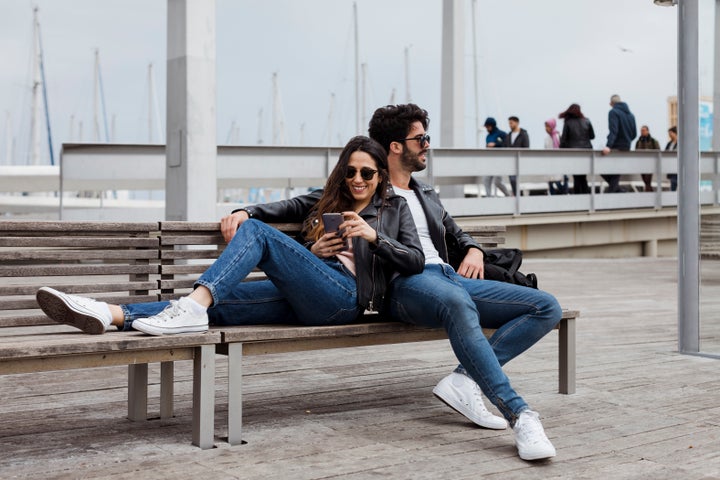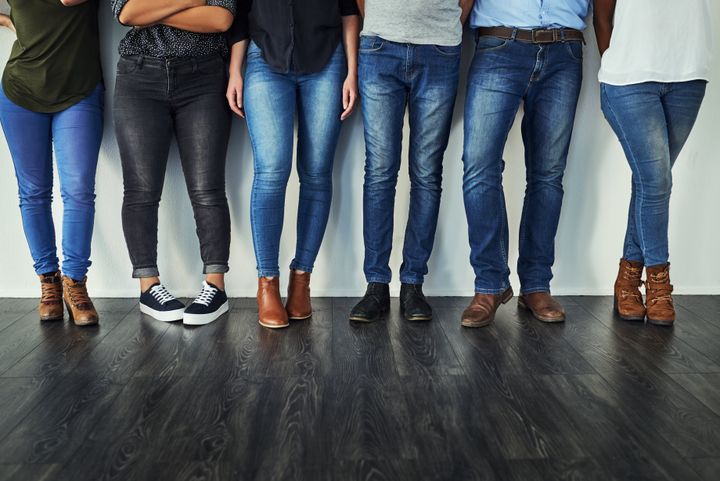FYI, if your back pockets are angled wrong, they can create the illusion of a droopy butt.
Jeans are a staple of almost everyone’s wardrobe, but it feels impossible to find a pair you love that fits well. You might find jeans in a great color, only to discover that they are too stiff. Jeans that look great in the front may have an unsightly gap in the back. Sometimes jeans look perfect in the dressing room but expose your derriére when you try to sit down.
If you find yourself buying and returning jeans at an alarming rate, you aren’t alone. “Return rates are astronomically higher for bottoms than dresses or tops,” said Robyn Dombey, a fashion designer who designed jeans for Urban Outfitters and taught fashion design at Made Institute, Philadelphia. “Unlike tops, there is much more functionality and movement required for bottoms. Customers are therefore more particular, and rightly so, about the fit of bottoms,” she said.
Why is it so hard to find a pair of jeans that fit well and look great? And how can consumers find comfortable jeans that look great? We asked some top jeans designers for their tips.
How To Tell If A Pair Of Jeans Fits
Even if a pair of jeans looks great, they will sit in your closet if they don’t feel great. “What’s most important is that you feel good in what you’re wearing,” said Elizabeth Davey, director of product at Duer. Caren Lettiere, the founder and president of Democracy Clothing, says jeans that fit well should “feel comfortable and like a hug, but not tight like a squeeze.”
Dave Bowden, the founder of Irreverent Gent and a men’s style consultant, adds that “a good fit generally means you can sit, walk and move comfortably without the jeans riding up, sagging down or restricting movement.” He explains that a pair of jeans that fits well “snugly contours around your waist without needing a belt to stay up, provides comfort and mobility without excessive tightness or bagginess, and flatters your body according to the intended style and cut,” whether you prefer straight-legged or a wider leg. Additionally, Bowden says that fabric shouldn’t “pinch, bunch or create any unwanted discomfort, especially in the crotch, and particularly when sitting down.”
Go By Measurements, Not Size
Jean manufacturers don’t use standard sizing, which can make shopping for jeans difficult, Davey said. Even within the same brand, the same size may fit differently in a different style. According to Dombey, that’s because sizing is usually calculated on a scale called “grading.” She explained that many brands only test jeans in one size, often size 8. After that, she said that the rest of the sizes are usually based on “guesswork.” Other factors, such as the cut and fabric, can also impact sizing.
To find the perfect fit, Davey recommends taking your own measurements and referencing a manufacturer’s size chart to find a match. She suggests using a soft measuring tape directly against your skin. Start by placing the measuring tape above your belly button at the smallest part of your waist and wrapping it around your waist, ensuring it is snug, but not tight. Then, measure your inseam by measuring from where your leg joint meets your torso down to the ankle bone.
Although measuring your body will be more accurate, if this sounds too complicated, there is a workaround. If you have a pair of jeans that you think fits perfectly, Bowden recommends referencing that brand’s size chart, and using their measurements as a guide when buying a new pair.

Look For Jeans Created For Diverse Body Types
Dombey explained that because bodies come in so many “different shapes and sizes,” it is impossible for “manufacturers to create a simple list of sizes to accommodate us all.”
However, looking for styles created for your body type such as curvy or petite, can help. For example, Mary Pierson, senior vice president of denim design at Madewell, explained that Madewell created “curvy fits, tailored for those with smaller waists and a little more curve on their hips and thighs.” For many, this takes care of the common complaint of “jeans fitting the hips and thighs but having a loose waist,” she said. Pierson says Madewell also manufactures petite, tall, plus, plus curvy and men’s athletic slim fit styles to try to accommodate most body types.
Because everyone’s body shape is different, Lettiere recommends paying particular attention to how jeans fit where you carry the most weight, and homing in on a style that works for that part of your body. For most people, this will be their stomach, legs, hips or behinds, she shared.
Find The Right Rise For Your Body And Aesthetic
According to Bowden, selecting the correct rise for your jeans is “critically important” since the rise will impact how jeans fit around your waist and hips. However, just like you can’t go by the size on a label, Davey says not to rely on what type of rise is advertised, either. “A mid-rise on a shorter person can sit as a high-rise whereas a low-rise can sit uncomfortably low on a taller person,” Davey said.
Bowden said high-rise jeans that sit above your natural waist create a “vintage or polished look.” This style is flattering for most people because it accentuates the waist, which is the slimmest part of most people’s bodies, he said. High-rise jeans also tend to look good on shorter people who want to “elongate the appearance of their legs,” according to Bowden.
Those who prefer a “casual, laid-back style” should opt for low-rise jeans, Bowden suggested. Because low-rise jeans sit below the navel, they tend to work better for people with shorter torsos and those who want to accentuate their hips, he said.
For a universally flattering style, Bowden recommends mid-rise jeans. These “work well for most body types” because they “sit comfortably between the hips and belly button.” Although Bowden describes mid-rise jeans as a “safe, but not particularly fashion-forward choice,” he thinks they are “great for everyday wear” and take a lot of the guesswork out of finding a pair of jeans that fit.
Mind The Back
According to Lettiere, it’s essential to pay attention to how the back of your jeans fit. Lettiere recommends taking a picture “to capture the rearview because how the jeans look from behind is a critical factor in selecting a great pair of jeans.” That’s because “you want to look as good exiting the room as you do when you enter,” she said.
“There shouldn’t ever be gapping in the waistband. If you bend over and there is a big gap, then those jeans don’t work for you,” Lettiere said.
Jill Perliman, creative director at Liverpool Los Angeles, also recommends paying attention to details, such as the placement of rear pockets, to make sure they look flattering on your bottom. Personal stylist Juli Johnson says that higher pockets give the illusion of a butt lift and pockets with a slight angle create a “perky bum.” If pockets are too low, they will make your bottom look “droopy,” she said.

Consider The Length (And Try Them On With Your Shoes!)
Even if a pair of jeans fits well around your waist and bottom, you still need to look at the length. “The length of the jeans is a critical factor in achieving an optimal fit,” Davey said. Sometimes tailoring can take care of jeans that are too long, but there is no good solution for jeans that are too short. Moreover, getting frayed or flared cuts tailored might ruin the look you are going for.
Measuring your inseam is a good starting point when looking for jeans that hit at the right point on your leg, but it’s not the only factor. Lettiere suggests considering the type of shoe you plan on wearing when buying a pair of jeans. “The length of the jean correlates to your height, the length of your legs, and the type of shoe you plan to wear,” she explained. “For heels or wedges, you will need a longer inseam than you will for sneakers,” she said. If you are going for a cropped look that hits at the ankle, you will want jeans with a shorter inseam.
“Right now, people are looking for a straight cut that stacks slightly on the shoe, so a longer cut is used to achieve this look,” Davey said. However, unless you are going for a casual, oversized look, Bowden cautions that “if there’s too much bunching around the ankles, then the jeans are probably too long.”
Not All Denim Fabrics Are Created Equal
To find jeans that both look and feel good, look for a pair that has a combination of stretch and rigid fabrics.
Stretch denim gives the best, and most comfortable fit, Perliman explained. However, stretch jeans are usually not a good choice. They don’t have good “recovery” and won’t bounce back into shape after wearing them once or twice, she said.
Moreover, most stretch jeans look boring. Getting the “beautiful, worn-in vintage look” many designers try to replicate requires rigid, non-stretch denim,” Dombey said. However, rigid jeans also aren’t a good choice for most people. Although they look great, many people find them uncomfortable.
For the best of both worlds, Dombey recommends looking for jeans that have a combination of rigid and stretch fibers.
Johnson stresses that quality is key and that jeans are expensive for a reason. “Higher-end brands tend to use higher quality materials,” she said. This is especially important when it comes to jeans with stretch. The right combination of materials can “create a wonderful fit and comfort around your curves without stretching out over the course of your day,” she explained.
Although this may sound like a lot of work, it’s worth the effort. “Finding the right pair of jeans is always a hunt. It takes a bit of time and research, but once you discover that perfect pair, the joy is unmatched. There’s nothing better than a great-fitting pair of jeans,” Pierson said.
Credit: Source link